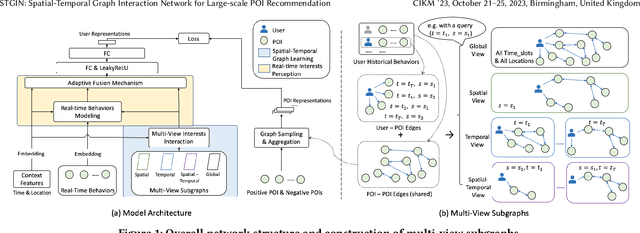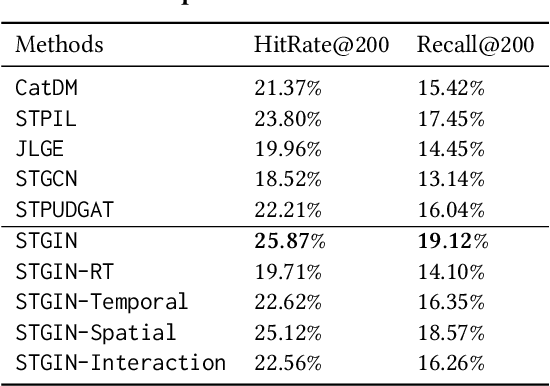Yu Qi
I Speak and You Find: Robust 3D Visual Grounding with Noisy and Ambiguous Speech Inputs
Jun 17, 2025Abstract:Existing 3D visual grounding methods rely on precise text prompts to locate objects within 3D scenes. Speech, as a natural and intuitive modality, offers a promising alternative. Real-world speech inputs, however, often suffer from transcription errors due to accents, background noise, and varying speech rates, limiting the applicability of existing 3DVG methods. To address these challenges, we propose \textbf{SpeechRefer}, a novel 3DVG framework designed to enhance performance in the presence of noisy and ambiguous speech-to-text transcriptions. SpeechRefer integrates seamlessly with xisting 3DVG models and introduces two key innovations. First, the Speech Complementary Module captures acoustic similarities between phonetically related words and highlights subtle distinctions, generating complementary proposal scores from the speech signal. This reduces dependence on potentially erroneous transcriptions. Second, the Contrastive Complementary Module employs contrastive learning to align erroneous text features with corresponding speech features, ensuring robust performance even when transcription errors dominate. Extensive experiments on the SpeechRefer and peechNr3D datasets demonstrate that SpeechRefer improves the performance of existing 3DVG methods by a large margin, which highlights SpeechRefer's potential to bridge the gap between noisy speech inputs and reliable 3DVG, enabling more intuitive and practical multimodal systems.
EquAct: An SE(3)-Equivariant Multi-Task Transformer for Open-Loop Robotic Manipulation
May 27, 2025Abstract:Transformer architectures can effectively learn language-conditioned, multi-task 3D open-loop manipulation policies from demonstrations by jointly processing natural language instructions and 3D observations. However, although both the robot policy and language instructions inherently encode rich 3D geometric structures, standard transformers lack built-in guarantees of geometric consistency, often resulting in unpredictable behavior under SE(3) transformations of the scene. In this paper, we leverage SE(3) equivariance as a key structural property shared by both policy and language, and propose EquAct-a novel SE(3)-equivariant multi-task transformer. EquAct is theoretically guaranteed to be SE(3) equivariant and consists of two key components: (1) an efficient SE(3)-equivariant point cloud-based U-net with spherical Fourier features for policy reasoning, and (2) SE(3)-invariant Feature-wise Linear Modulation (iFiLM) layers for language conditioning. To evaluate its spatial generalization ability, we benchmark EquAct on 18 RLBench simulation tasks with both SE(3) and SE(2) scene perturbations, and on 4 physical tasks. EquAct performs state-of-the-art across these simulation and physical tasks.
Human-like Cognitive Generalization for Large Models via Brain-in-the-loop Supervision
May 14, 2025Abstract:Recent advancements in deep neural networks (DNNs), particularly large-scale language models, have demonstrated remarkable capabilities in image and natural language understanding. Although scaling up model parameters with increasing volume of training data has progressively improved DNN capabilities, achieving complex cognitive abilities - such as understanding abstract concepts, reasoning, and adapting to novel scenarios, which are intrinsic to human cognition - remains a major challenge. In this study, we show that brain-in-the-loop supervised learning, utilizing a small set of brain signals, can effectively transfer human conceptual structures to DNNs, significantly enhancing their comprehension of abstract and even unseen concepts. Experimental results further indicate that the enhanced cognitive capabilities lead to substantial performance gains in challenging tasks, including few-shot/zero-shot learning and out-of-distribution recognition, while also yielding highly interpretable concept representations. These findings highlight that human-in-the-loop supervision can effectively augment the complex cognitive abilities of large models, offering a promising pathway toward developing more human-like cognitive abilities in artificial systems.
Two by Two: Learning Multi-Task Pairwise Objects Assembly for Generalizable Robot Manipulation
Apr 09, 2025Abstract:3D assembly tasks, such as furniture assembly and component fitting, play a crucial role in daily life and represent essential capabilities for future home robots. Existing benchmarks and datasets predominantly focus on assembling geometric fragments or factory parts, which fall short in addressing the complexities of everyday object interactions and assemblies. To bridge this gap, we present 2BY2, a large-scale annotated dataset for daily pairwise objects assembly, covering 18 fine-grained tasks that reflect real-life scenarios, such as plugging into sockets, arranging flowers in vases, and inserting bread into toasters. 2BY2 dataset includes 1,034 instances and 517 pairwise objects with pose and symmetry annotations, requiring approaches that align geometric shapes while accounting for functional and spatial relationships between objects. Leveraging the 2BY2 dataset, we propose a two-step SE(3) pose estimation method with equivariant features for assembly constraints. Compared to previous shape assembly methods, our approach achieves state-of-the-art performance across all 18 tasks in the 2BY2 dataset. Additionally, robot experiments further validate the reliability and generalization ability of our method for complex 3D assembly tasks.
MME-CoT: Benchmarking Chain-of-Thought in Large Multimodal Models for Reasoning Quality, Robustness, and Efficiency
Feb 13, 2025



Abstract:Answering questions with Chain-of-Thought (CoT) has significantly enhanced the reasoning capabilities of Large Language Models (LLMs), yet its impact on Large Multimodal Models (LMMs) still lacks a systematic assessment and in-depth investigation. In this paper, we introduce MME-CoT, a specialized benchmark evaluating the CoT reasoning performance of LMMs, spanning six domains: math, science, OCR, logic, space-time, and general scenes. As the first comprehensive study in this area, we propose a thorough evaluation suite incorporating three novel metrics that assess the reasoning quality, robustness, and efficiency at a fine-grained level. Leveraging curated high-quality data and a unique evaluation strategy, we conduct an in-depth analysis of state-of-the-art LMMs, uncovering several key insights: 1) Models with reflection mechanism demonstrate a superior CoT quality, with Kimi k1.5 outperforming GPT-4o and demonstrating the highest quality results; 2) CoT prompting often degrades LMM performance on perception-heavy tasks, suggesting a potentially harmful overthinking behavior; and 3) Although the CoT quality is high, LMMs with reflection exhibit significant inefficiency in both normal response and self-correction phases. We hope MME-CoT serves as a foundation for advancing multimodal reasoning in LMMs. Project Page: https://mmecot.github.io/
ThinkGrasp: A Vision-Language System for Strategic Part Grasping in Clutter
Jul 16, 2024



Abstract:Robotic grasping in cluttered environments remains a significant challenge due to occlusions and complex object arrangements. We have developed ThinkGrasp, a plug-and-play vision-language grasping system that makes use of GPT-4o's advanced contextual reasoning for heavy clutter environment grasping strategies. ThinkGrasp can effectively identify and generate grasp poses for target objects, even when they are heavily obstructed or nearly invisible, by using goal-oriented language to guide the removal of obstructing objects. This approach progressively uncovers the target object and ultimately grasps it with a few steps and a high success rate. In both simulated and real experiments, ThinkGrasp achieved a high success rate and significantly outperformed state-of-the-art methods in heavily cluttered environments or with diverse unseen objects, demonstrating strong generalization capabilities.
MindGPT: Interpreting What You See with Non-invasive Brain Recordings
Sep 27, 2023Abstract:Decoding of seen visual contents with non-invasive brain recordings has important scientific and practical values. Efforts have been made to recover the seen images from brain signals. However, most existing approaches cannot faithfully reflect the visual contents due to insufficient image quality or semantic mismatches. Compared with reconstructing pixel-level visual images, speaking is a more efficient and effective way to explain visual information. Here we introduce a non-invasive neural decoder, termed as MindGPT, which interprets perceived visual stimuli into natural languages from fMRI signals. Specifically, our model builds upon a visually guided neural encoder with a cross-attention mechanism, which permits us to guide latent neural representations towards a desired language semantic direction in an end-to-end manner by the collaborative use of the large language model GPT. By doing so, we found that the neural representations of the MindGPT are explainable, which can be used to evaluate the contributions of visual properties to language semantics. Our experiments show that the generated word sequences truthfully represented the visual information (with essential details) conveyed in the seen stimuli. The results also suggested that with respect to language decoding tasks, the higher visual cortex (HVC) is more semantically informative than the lower visual cortex (LVC), and using only the HVC can recover most of the semantic information. The code of the MindGPT model will be publicly available at https://github.com/JxuanC/MindGPT.
STGIN: Spatial-Temporal Graph Interaction Network for Large-scale POI Recommendation
Sep 05, 2023



Abstract:In Location-Based Services, Point-Of-Interest(POI) recommendation plays a crucial role in both user experience and business opportunities. Graph neural networks have been proven effective in providing personalized POI recommendation services. However, there are still two critical challenges. First, existing graph models attempt to capture users' diversified interests through a unified graph, which limits their ability to express interests in various spatial-temporal contexts. Second, the efficiency limitations of graph construction and graph sampling in large-scale systems make it difficult to adapt quickly to new real-time interests. To tackle the above challenges, we propose a novel Spatial-Temporal Graph Interaction Network. Specifically, we construct subgraphs of spatial, temporal, spatial-temporal, and global views respectively to precisely characterize the user's interests in various contexts. In addition, we design an industry-friendly framework to track the user's latest interests. Extensive experiments on the real-world dataset show that our method outperforms state-of-the-art models. This work has been successfully deployed in a large e-commerce platform, delivering a 1.1% CTR and 6.3% RPM improvement.
A Human-Machine Joint Learning Framework to Boost Endogenous BCI Training
Aug 25, 2023



Abstract:Brain-computer interfaces (BCIs) provide a direct pathway from the brain to external devices and have demonstrated great potential for assistive and rehabilitation technologies. Endogenous BCIs based on electroencephalogram (EEG) signals, such as motor imagery (MI) BCIs, can provide some level of control. However, mastering spontaneous BCI control requires the users to generate discriminative and stable brain signal patterns by imagery, which is challenging and is usually achieved over a very long training time (weeks/months). Here, we propose a human-machine joint learning framework to boost the learning process in endogenous BCIs, by guiding the user to generate brain signals towards an optimal distribution estimated by the decoder, given the historical brain signals of the user. To this end, we firstly model the human-machine joint learning process in a uniform formulation. Then a human-machine joint learning framework is proposed: 1) for the human side, we model the learning process in a sequential trial-and-error scenario and propose a novel ``copy/new'' feedback paradigm to help shape the signal generation of the subject toward the optimal distribution; 2) for the machine side, we propose a novel adaptive learning algorithm to learn an optimal signal distribution along with the subject's learning process. Specifically, the decoder reweighs the brain signals generated by the subject to focus more on ``good'' samples to cope with the learning process of the subject. Online and psuedo-online BCI experiments with 18 healthy subjects demonstrated the advantages of the proposed joint learning process over co-adaptive approaches in both learning efficiency and effectiveness.
NeuSort: An Automatic Adaptive Spike Sorting Approach with Neuromorphic Models
Apr 20, 2023Abstract:Spike sorting, which classifies spiking events of different neurons from single electrode recordings, is an essential and widely used step in neural data processing and analysis. The recent development of brain-machine interfaces enables online control of external devices and closed-loop neuroprosthetics using single-unit activity, making online spike sorting desired. Most existing spike sorters work in an offline manner, i.e., sorting after data collection. However, offline spike sorters usually suffer from performance degradation in online tasks due to the instability of neural signals. In an online process, neuronal properties can change over time (such as waveform deformations), and new neurons can appear. Therefore, a static spike sorter requires periodic recalibration to maintain its performance. This study proposes a novel online spike sorter based on neuromorphic models (NeuSort), which can adaptively adjust itself to cope with changes in neural signals. NeuSort can robustly track individual neurons' activities against waveform deformations and automatically recognize new coming neurons in real-time. The adaptation ability of NeuSort is achieved by online parameter updates of the neuromorphic model, according to the plasticity learning rule inspired by biological neural systems. Experimental results on both synthetic and neural signal datasets demonstrate that NeuSort can classify spiking events automatically and cope with non-stationary situations in neural signals. NeuSort also provides ultra-low energy cost computation with neuromorphic chips.
 Add to Chrome
Add to Chrome Add to Firefox
Add to Firefox Add to Edge
Add to Edge